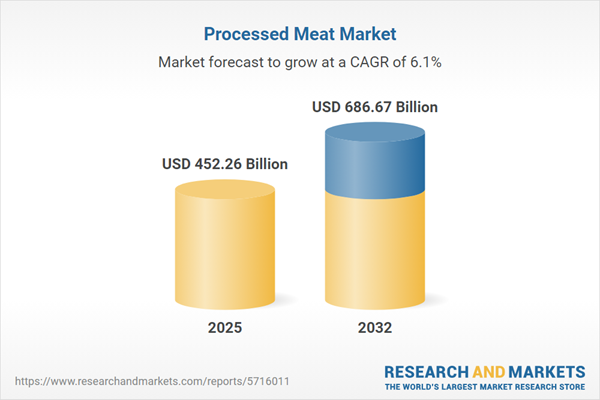Speak directly to the analyst to clarify any post sales queries you may have.
The processed meat market is experiencing significant transformation as evolving consumer demands, technological advancements, and regulatory shifts reshape the sector. Senior decision-makers face both fresh challenges and new growth opportunities as they navigate a changing global landscape within the processed meat industry.
Processed Meat Market Snapshot
The Processed Meat Market grew from USD 427.75 billion in 2024 to USD 452.26 billion in 2025, representing a sustained period of expansion. With a projected CAGR of 6.09%, the market is forecast to reach USD 686.67 billion by 2032, reflecting rising demand, shifting consumption patterns, and evolving production technologies.
Scope & Segmentation
This report delivers actionable insights across processed meat types, product formats, channels, regional performance, and corporate strategies. Market segmentation and regional dynamics are covered as follows:
- Meat Types: Includes beef, mutton & lamb, pork, poultry, and seafood, enabling granular analysis of consumer preference shifts and protein source diversification.
- Product Formats: Encompasses canned, dried, and frozen meat, with each format tailored to specific consumer needs such as shelf stability or meal convenience.
- Distribution Channels: Spans offline outlets (butcher shops, specialty stores, convenience stores, supermarkets/hypermarkets) and online platforms, reflecting omnichannel transformations.
- End-Use Industries: Covers foodservice providers, including cafeterias and restaurants, as well as household consumers seeking convenience and variety.
- Regions: Offers detailed coverage of Americas (United States, Canada, Mexico, Brazil, Argentina, Chile, Colombia, Peru), Europe, Middle East & Africa (United Kingdom, Germany, France, Russia, Italy, Spain, Netherlands, Sweden, Poland, Switzerland, UAE, Saudi Arabia, Qatar, Turkey, Israel, South Africa, Nigeria, Egypt, Kenya), and Asia-Pacific (China, India, Japan, Australia, South Korea, Indonesia, Thailand, Malaysia, Singapore, Taiwan).
- Industry Participants: Analyzes strategic moves and portfolios of companies such as American Foods Group, LLC, Cargill, Incorporated, Conagra Brands, Inc., Danish Crown A/S, JBS SA, Tyson Foods, Inc., and WH Group Limited, among others.
Key Takeaways for Senior Decision-Makers
- The processed meat industry is becoming more dynamic as technological innovation and health-conscious trends reshape product development and portfolio strategies.
- Flexitarian and sustainability-driven trends are accelerating investment in hybrid meat and plant-based offerings, driving collaboration across traditional and alternative protein segments.
- Advanced automation, digital twins, predictive analytics, and blockchain-based traceability are optimizing operational efficiency and improving supply chain transparency.
- Shifts in regulatory frameworks heighten accountability, making compliance with evolving safety and sustainability standards crucial for market access and consumer trust.
- Regional variations require tailored approaches—such as premiumization in established markets and product adaptation in fast-growing regions—to align with local consumer preferences and infrastructure.
- Strategic partnerships and acquisitions are empowering market leaders to balance broad mass-market presence with niche, high-margin brands, while expanding their geographic reach.
Tariff Impact on Market Dynamics
Recent U.S. tariff changes have caused a marked shift in global processed meat trade flows and pricing strategies. New levies prompted producers to focus on operational efficiency and cost management, while importers seek diversification in sourcing. Distributors and retailers have responded through contract renegotiations and private-label initiatives, highlighting the need for robust supply chain risk strategies. Increased collaboration and technology investment have helped buffer disruptions and preserve access to diverse product lines for buyers.
Processed Meat Market Methodology & Data Sources
Insights are grounded in qualitative and quantitative research, comprising secondary reviews of industry publications and regulatory documents, primary interviews with key executives throughout the value chain, and regionally targeted quantitative surveys. Custom datasets, trade statistics, and advanced data modeling support triangulation and scenario analysis for reliable, comprehensive findings.
Why This Report Matters
- Enables strategic planning by illuminating emerging trends in processed meat consumption, distribution, and production technologies across major global markets.
- Provides senior decision-makers with a clear view of challenges and opportunities shaped by regulatory shifts, supply chain disruptions, and competitive strategies.
- Supports investment and partnership decisions with robust profiling of leading market participants and regional growth prospects.
Conclusion
The processed meat market is positioned for ongoing evolution, driven by consumer trends, regulatory changes, and operational innovation. Adapting to these dynamics will be critical for business leaders intent on resilient, sustainable growth in a rapidly changing environment.
Additional Product Information:
- Purchase of this report includes 1 year online access with quarterly updates.
- This report can be updated on request. Please contact our Customer Experience team using the Ask a Question widget on our website.
Table of Contents
3. Executive Summary
4. Market Overview
7. Cumulative Impact of Artificial Intelligence 2025
Companies Mentioned
The companies profiled in this Processed Meat market report include:- American Foods Group, LLC
- Cargill, Incorporated
- Cherkizovo Group
- Clover Leaf Foods Inc.
- Conagra Brands, Inc.
- Danish Crown A/S
- Foster Farms LLC.
- Hormel Foods Corporation
- JBS SA
- Lake Erie Packers, Inc.
- Maple Leaf Foods Inc.
- Marfrig Global Foods S.A.
- Mountaire Farms, Inc.
- NH Foods Ltd.
- OSI Group, LLC
- Perdue Farms Inc.
- Seaboard Corporation
- Smithfield Foods, Inc.
- The Kraft Heinz Company
- Tyson Foods, Inc.
- Vion Food Group N.V.
- WH Group Limited
Table Information
| Report Attribute | Details |
|---|---|
| No. of Pages | 183 |
| Published | November 2025 |
| Forecast Period | 2025 - 2032 |
| Estimated Market Value ( USD | $ 452.26 Billion |
| Forecasted Market Value ( USD | $ 686.67 Billion |
| Compound Annual Growth Rate | 6.0% |
| Regions Covered | Global |
| No. of Companies Mentioned | 23 |









